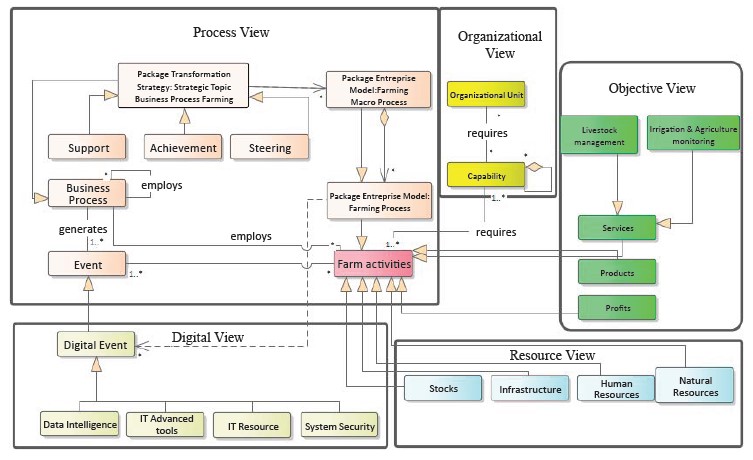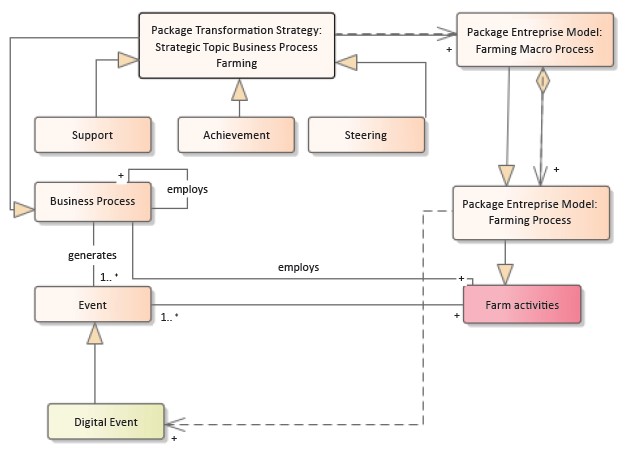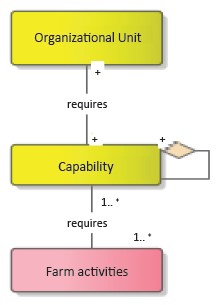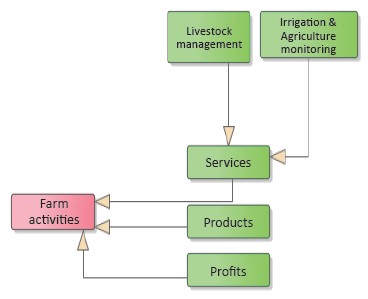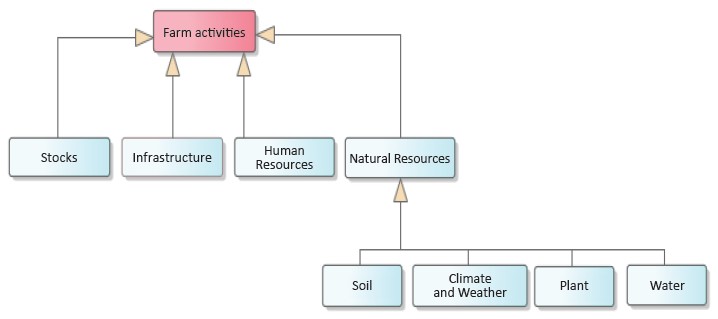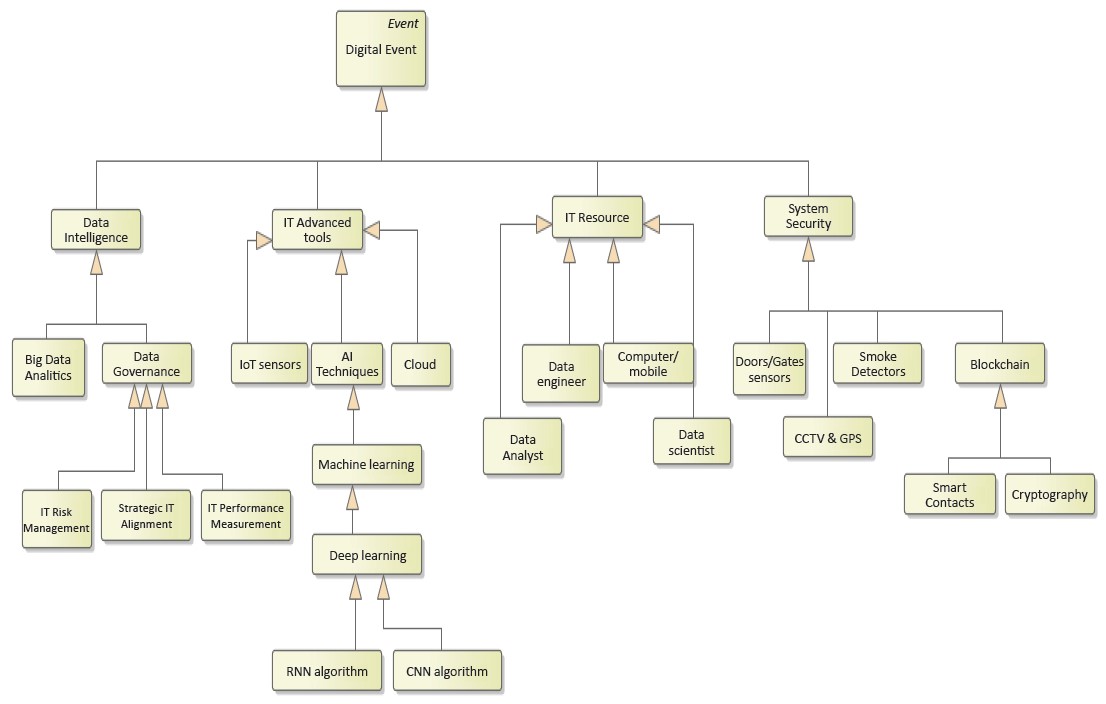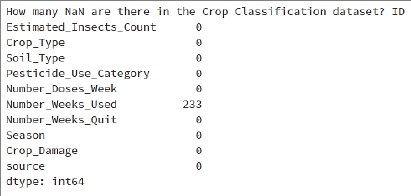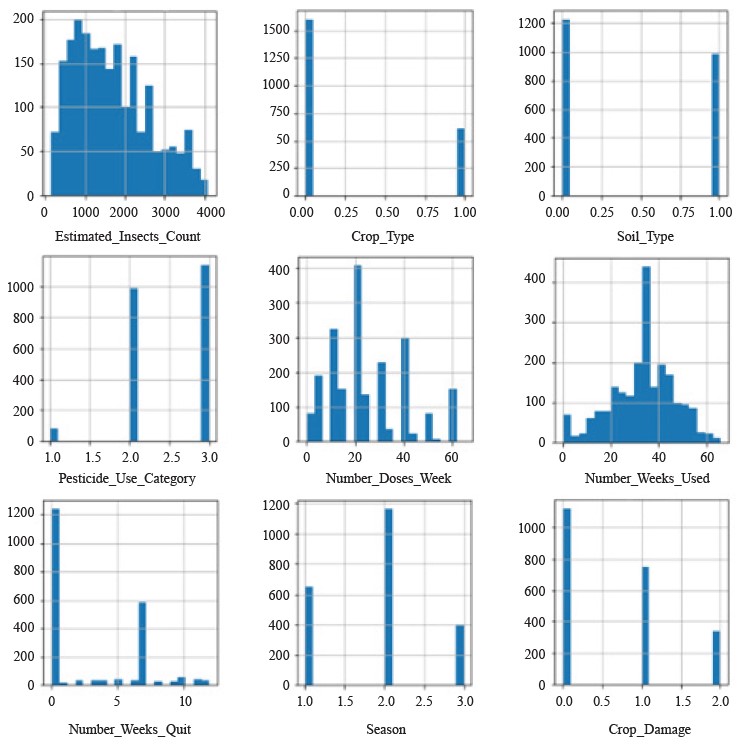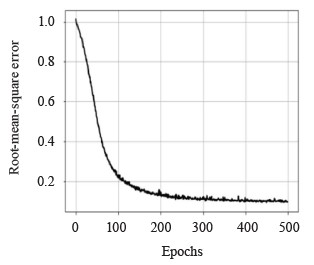Abstract
Agriculture 4.0 is an opportunity for farmers to meet the current challenges in food production. It has become necessary to adopt a set of agricultural practices based on advanced technologies. Agriculture 4.0 enables farms to create added value by combining innovative technologies, such as precision agriculture, information and communication technology, robotics, and Big Data.As an enterprise, a connected farm is highly sensitive to strategic changes in organizational structures, objectives, modified variety, new business objects, processes, etc. To control the farm’s information system strategically, we proposed a metamodel based on the ISO/IS 19440 standard, where we added some new constructs relating to advanced digital technologies for smart and connected agriculture.
We applied the proposed metamodel to the crop classification prediction process. This involved using machine learning methods such as recurrent neural networks to predict the type of crop being grown in a given agricultural area.
Our research bridges farming with modern technology through our metamodel for a connected farm, promoting sustainability and efficiency. Furthermore, our crop classification study demonstrates the power of advanced machine learning, guided by our metamodel, in accurately predicting crop conditions, emphasizing its potential for crop management and food security. In essence, our work advances the transformative role of digital agriculture in modern farming.
Keywords
Farm modeling, digital agriculture, agriculture 4.0, advanced technologies, connected farm, ISO 19440-2007INTRODUCTION
The agricultural sector is an important contributor to the Moroccan economy, employing over 40% of the population and accounting for nearly 15% of the country’s Gross Domestic Product (GDP). The farming sector in Morocco comprises small-scale, family-owned farms that produce a variety of crops, including cereals, fruits, vegetables, and livestock. The most important crops in terms of production and revenue are cereals (wheat and barley) and fruits (citrus, olives, and dates). Over the past few decades, Morocco has invested greatly in the agricultural sector to develop irrigation systems and promote modern farming techniques. These efforts have helped increase productivity and improve the quality of agricultural products, which has led to greater exports and a stronger economy.
Despite these advancements, the farming sector in Morocco still faces challenges, such as water scarcity, soil degradation, and the need for greater infrastructure development. Nevertheless, the Moroccan government continues to prioritize the agricultural sector as a key driver of economic growth and development, and there is a growing interest in sustainable farming practices and organic farming methods.
Digital farming, also known as smart agriculture, is a modern farming approach that harnesses the power of data, technology, and automation to improve the efficiency and productivity of agricultural practices [1]. Digital farming involves the use of various tools and technologies, such as sensors, drones, GPS systems, and data analytics, to collect and analyze data about crops, soil conditions, weather patterns, and other factors that affect agricultural production [2].
One of the key benefits of digital farming is its ability to provide farmers with real-time, data-driven insights into their farming practices. For example, sensors can be used to monitor soil moisture, plant growth, and nutrient levels, allowing farmers to optimize their use of water, fertilizers, and other resources. Drones equipped with high-resolution cameras can also be used to provide detailed images of crops, helping farmers identify potential problems, such as pests, diseases, and nutrient deficiencies. Digital farming can also help farmers optimize their planting schedules and improve crop yields by using data-driven decision-making tools. By analyzing data on weather patterns, soil conditions, and other factors, farmers can make more informed decisions about when and where to plant their crops, reducing waste and increasing yields [3].Other benefits of digital farming include reduced environmental impact, improved crop quality, and increased efficiency and profitability. However, digital farming also requires significant investment in technology and infrastructure, as well as specialized knowledge and skills.
In this paper, we propose incorporating the ISO 19440 standard into the agricultural landscape. This can herald a new era of informed and efficient farming. By treating a farm as an organized enterprise and harnessing the power of standardized data modeling and information management, the agricultural sector can achieve unprecedented levels of productivity, sustainability, and collaboration. The principles embedded within ISO 19440 can be employed to streamline and elevate farm management by providing a structured approach to data modeling and information management.
Crop classification is an agricultural process that involves identifying and categorizing different types of crops based on their characteristics, such as appearance, growth habits, and agricultural practices. Crops can be classified in many different ways, including by their:
– use: some crops are grown for human consumption (wheat, rice, and corn), while others are grown for animal feed or industrial uses (cotton or tobacco);
– growing season: crops can be classified as annuals, which complete their life cycle within a single year, or perennials, which live for multiple years;
– growth habits: crops can be vines, shrubs, or trees;
– climate requirements: some crops require specific climatic conditions, such as a certain amount of rainfall or temperature range, while others are more adaptable to a range of conditions;
– soil requirements: crops have different soil requirements, such as pH levels, nutrient content, and drainage; and
– geographic origin: some crops are native to specific regions of the world, while others were introduced and adapted to new environments.
Crop classification is important for farmers and policymakers, as it helps them identify the best practices for growing and managing different types of crops, as well as understand their potential impact on the environment and local economies.
In this study, we aimed to outline a strategic plan for navigating the digital evolution of agricultural practices. For this, we introduced a model for transformation and examined its implications against ISO 19440:2007 “Enterprise Integration” by conceptualizing a farm as a structured enterprise. Then, we elucidated the empirical findings of our case study involving crop classification prediction and scrutinized our methodology. Lastly, we deliberated on the originality and practicality of our proposed metamodel, as well as proposed potential avenues for future research.STUDY OBJECTS AND METHODS
From Agriculture 1.0 to Agriculture 4.0. The digital revolution is a societal shift that impacts both our personal and professional lives. The incorporation of novel technologies and the rise of innovative practices have fundamentally altered our society, influencing its culture, structure, and organization. Recent innovations, such as Cloud computing, Internet of Things (IoT), Big Data analytics, and Virtual Reality, have gradually become integral across various industries [4]. Beyond the mere utilization of these novel tools, the convergence between the digital realm and the professional sphere has prompted attention to several key aspects: digitalization, communication and collaboration, globalization, and competitiveness [5].
This transformation has had a profound effect on the agricultural sector, a pivotal player in the Moroccan economy. As a result, a new paradigm for farming has emerged – one that is interconnected, intelligent, adaptable, and community-oriented, with a special emphasis on customer involvement.
The evolution of agriculture can be categorized into different “Agriculture” eras, ranging from Agriculture 1.0 to Agriculture 4.0. These eras are characterized by different stages of technological advancement and significant changes in agricultural practices over time.
Agriculture 1.0 is often referred to as the “subsistence agriculture” era, where manual labor and traditional methods were used for farming. This era began around 10 000 years ago, during the Neolithic Revolution, and lasted until the 19th century.
Agriculture 2.0, also known as the “mechanized agriculture” era, began in the 19th century and was characterized by the introduction of machines, such as tractors, seed drills, and threshing machines. This era led to significant improvements in agricultural productivity and efficiency.
Agriculture 3.0, also known as the “Green Revolution” era, began in the mid-20th century and was characterized by the development of new technologies, such as high-yielding crop varieties, synthetic fertilizers, and pesticides. This era led to a significant increase in global agricultural productivity, enabling farmers to produce more food than ever before.
Agriculture 4.0, also known as the “digital agriculture” era, is the current stage of agricultural development, characterized by the integration of advanced digital technologies, such as the Internet of Things (IoT), artificial intelligence (AI), and robotics [6]. This era is focused on increasing agricultural efficiency, reducing waste, and improving sustainability through the use of data-driven decision-making, precision farming, and other digital agricultural processes [7].Overall, the transition from Agriculture 1.0 to Agriculture 4.0 has led to significant improvements in agricultural productivity, efficiency, and sustainability, enabling farmers to produce more food with fewer resources and reducе the environmental impact of agricultural practices.
Research methodology. Modeling a connected farm based on the ISO 19440 Enterprise Metamodel, which views a farm as an enterprise, involves a comprehensive approach to integrating technological advancements into agricultural operations [8]. This metamodel recognizes that a farm functions as a dynamic and interconnected entity, encompassing diverse processes such as crop cultivation, livestock management, resource allocation, and supply chain logistics. By applying the principles of ISO 19440, we can represent the farm as a network of interconnected systems, where data-driven decisionmaking becomes central to optimizing productivity and sustainability. Just as the enterprise model captures interactions between departments and stakeholders, this approach acknowledges intricate relationships between various aspects of agriculture, enabling the deployment of advanced technologies (IoT devices, sensors, and data analytics) to streamline operations, enhance resource efficiency, and ultimately achieve better outcomes across the agricultural value chain [9].
A metamodel of a connected farm encompasses several essential perspectives, namely the Process View, Organizational View, Objective View, Resource View, and Digital View (Fig. 1) [10].
The Process View focuses on various steps and activities involved in the operation of a connected farm. It includes processes such as crop management, livestock rearing, water and energy resource management, environmental monitoring, and harvesting. The Process View aims to identify workflows, dependencies, and interactions among these processes, ensuring efficient and streamlined operations throughout the farm.
The Organizational View delves into the structure and hierarchy of a connected farm. It defines the roles, responsibilities, and relationships among different stakeholders, including farm owners, managers, workers, and technicians. This perspective also considers communication channels and decision-making processes within the farm, ensuring clear lines of authority and effective collaboration.
The Objective View outlines the goals and objectives of a connected farm. It encompasses both short-term and long-term objectives such as maximizing crop yield, optimizing resource utilization, improving sustainability, ensuring animal welfare, and enhancing overall profitability. The Objective View provides a strategic framework for decision-making and guides the allocation of resources to achieve the desired outcomes.
The Resource View focuses on various resources required for the functioning of a connected farm. This includes physical resources (land, machinery, buildings, and infrastructure), as well as human resources (skilled labor, technicians, and farm workers). Additionally, it considers the availability and allocation of natural resources, such as water, energy, and nutrients. The Resource View ensures efficient utilization of resources, whileminimizing waste and environmental impact.The Digital View encompasses the technological aspects of a connected farm. It involves the integration of sensors, actuators, and other IoT (Internet of Things) devices to collect real-time data on various farm parameters such as soil moisture, temperature, humidity, livestock health, and equipment status. This data is then processed and analyzed using advanced analytics and machine learning algorithms to derive meaningful insights [11]. The Digital View enables data-driven decision-making, precision agriculture practices, and remote monitoring and control of farm operations.
With these perspectives, the metamodel of a connected farm provides a holistic framework for understanding and optimizing the complex interplay of processes, organizations, objectives, resources, and digital technologies. It facilitates the design, implementation, and management of an intelligent and efficient farm ecosystem that leverages technology to drive sustainable and profitable agricultural practices.
The Process View in a connected farm encompasses a detailed examination of various steps and activities involved in the farm’s operation. It aims to optimize workflows, dependencies, and interactions among different processes to ensure efficient and streamlined operations throughout the farm ecosystem.
The Process View identifies and analyzes different processes, such as crop management, livestock rearing, water and energy resource management, environmental monitoring, harvesting, and others. Each process is broken down into its constituent activities, tasks, and subtasks, providing a granular understanding of the farm’s operational procedures (Fig. 2).
For example, crop management involves such activities as soil preparation, seed sowing, irrigation, fertilization, pest and disease control, and crop monitoring [12]. The Process View examines the sequence of these activities, their interdependencies, as well as inputs and outputs associated with each step. This level of detail allows farm managers to identify potential bottlenecks, inefficiencies, or areas for improvement within the crop management process.
Similarly, in livestock rearing, the Process View encompasses activities such as animal feeding, health monitoring, breeding, housing management, and waste management. By analyzing these processes, farm operators can optimize feeding schedules, implement effective health monitoring systems, enhance breeding practices, improve waste management techniques, and ensure the overall well-being of livestock.
The Process View also considers cross-cutting processes such as water and energy resource management and environmental monitoring. It examines the utilization of water and energy resources throughout the farm, identifying opportunities for conservation, efficiency improvement, and sustainable practices. Additionally, it addresses environmental monitoring processes to ensure compliance with regulations and to proactively mitigate any potential environmental impact.By understanding and optimizing the processes within a connected farm, farm owners and managers can enhance operational efficiency, reduce waste, improve resource utilization, and ultimately achieve higher productivity and profitability. Thus, the Process View provides a foundation for continuous improvement and innovation, as well as a framework for implementing best practices and adopting emerging technologies in farm operations.
The Organizational View within a connected farm entails a comprehensive examination of the structure, hierarchy, and relationships among various stakeholders involved in the farm’s operations. It aims to establish a clear understanding of roles, responsibilities, and communication channels to ensure effective collaboration and decision-making (Fig. 3).
Within the Organizational View, the farm’s structure and hierarchy are defined, as well as different positions and levels of authority within the organization. This includes identifying farm owners, managers, supervisors, workers, technicians, and other key personnel. By clarifying these roles, the Organizational View establishes a framework for accountability and promotes efficient coordination within the farm.
Additionally, the Organizational View considers relationships among individuals and groups within the farm. It examines communication channels, reporting lines, and decision-making processes to facilitate effective information flow and decision-making. Clear lines of communication and well-defined reporting structures enable timely dissemination of information, quick problem resolution, and efficient coordination of activities.
The Organizational View also takes into account specific responsibilities and tasks assigned to each role within the farm. By clearly defining these responsibilities, it ensures that every stakeholder understands their role in contributing to the overall success of the farm. This clarity promotes efficiency, reduces duplication of efforts, and enhances productivity across the organization.
Furthermore, the Organizational View encourages a culture of collaboration and teamwork within the farm. It establishes mechanisms for effective collaboration, such as regular meetings, cross-functional teams, and knowledge-sharing platforms. By fostering a collaborative environment, the Organizational View enhances innovation, problem-solving, and continuous improvement within the farm.
Ultimately, the Organizational View aims to optimize the farm’s human resources by aligning roles, responsibilities, and relationships to achieve the farm’s objectives. It promotes a harmonious working environment, empowers individuals to contribute their expertise effectively, and facilitates efficient decision-making processes. By ensuring a well-structured and organized farm, the Organizational View sets a foundation for performing successful operations and achieving the desired outcomes.
The Objective View in a connected farm aims to define and align its goals and objectives to guide the farm’s strategic direction and decision-making processes. It provides a framework for setting both short-term and longterm objectives that are in line with the farm’s mission, vision, and values (Fig. 4).
Within the Objective View, the farm’s goals and objectives are established based on various factors such as market conditions, customer demands, regulatory requirements, and the farm’s unique circumstances. These objectives may include maximizing crop yield, optimizing resource utilization, improving sustainability practices, ensuring animal welfare, enhancing profitability, and adopting innovative technologies.
Short-term objectives focus on immediate targets that can be achieved within a relatively short timeframe, often in alignment with the current growing season or operational cycle. These objectives could include improving irrigation efficiency, reducing pesticide usage, or implementing precision agriculture techniques for specific crops [13].
Long-term objectives, on the other hand, outline broader aspirations and strategic aims for the farm. These objectives may encompass sustainable land management
practices, diversification of crop production, adoption of renewable energy sources, or implementation of advanced data analytics for the farm’s decision-making.
The Objective View also involves prioritizing objectives based on their importance, feasibility, and potential impact. This prioritization ensures that resources, such as time, labor, and capital investments, are allocated effectively to achieve the desired outcomes. By setting clear objectives, the farm can focus its efforts and resources on areas that contribute most significantly to its success.
Furthermore, the Objective View plays a crucial role in measuring and evaluating the farm’s performance against the defined objectives. Key performance indicators (KPIs) are established to track progress and assess the effectiveness of strategies and initiatives implemented to achieve the objectives. Regular monitoring and evaluation allow for adjustments, refinements, and identification of areas for improvement.
By integrating the Objective View into the farm’s operations, owners and managers can effectively align their decision-making processes with the overall strategic goals. This alignment ensures that day-to-day activities, resource allocation, and investments are in line with the desired outcomes, driving the farm towards long-term success, sustainability, and profitability.
The Resource View within a connected farm encompasses a comprehensive assessment of various resources required for the farm’s operations. It involves an examination of both physical and human resources, as well as efficient management and allocation of these resources to support sustainable and productive farming practices (Fig. 5).
In terms of physical resources, the Resource View considers assets such as land, machinery, buildings, infrastructure, and other agricultural inputs. It evaluates the availability, quality, and suitability of land for different crops and livestock rearing. Additionally, it examines the farm’s infrastructure, including irrigation systems, storage facilities, and equipment, ensuring that they are properly maintained and utilized to support efficient farm operations.
The Resource View also addresses management of human resources within the farm. It involves assessing the skills, knowledge, and expertise of the farm’s workforce, including skilled labor, technicians, farm workers, and management personnel. The Resource View aims to ensure that the right people are assigned to the right tasks, optimizing productivity and leveraging the strengths of individuals within the organization.
Furthermore, the Resource View encompasses the availability and allocation of natural resources such as water, energy, and nutrients. It considers sustainable practices for water management, including irrigation techniques that minimize water waste and maximize efficiency. It also examines energy consumption and explores opportunities for renewable energy sources to reduce the farm’s environmental footprint. Additionally, nutrient management strategies are evaluated to ensure efficient and responsible use of fertilizers and other inputs, minimizing pollution and maximizing soil health.
Efficient resource management is a key aspect of the Resource View. It involves optimizing resources’ utilization of while minimizing waste and environmental impact. This may include implementing precision agriculture technologies to precisely apply water, fertilizers, and pesticides only where and when they are needed, reducing resource waste. It may also involve adopting sustainable farming practices that promote soil health, biodiversity, and conservation of natural resources.
By analyzing and managing resources effectively, the Resource View supports the farm’s overall sustainability and profitability. It ensures that resources are used efficiently, reducing unnecessary costs and environmental impact. The Resource View also enables farm owners and managers to make informed decisions regarding investments, resource allocation, and adoption of new technologies, optimizing the farm’s performance and resilience in a rapidly changing agricultural landscape.
Within the Digital View, a network of sensors is deployed throughout the farm to gather data on parameters such as soil moisture, temperature, humidity, air quality, crop growth, livestock health, and equipment status. These sensors provide continuous monitoring and generate valuable data that can be analyzed and utilized for informed decision-making (Fig. 6) [15].
The collected data is transmitted to a centralized system or cloud platform where it is stored, processed, and analyzed using advanced analytics and machine learning algorithms [16]. This data analysis enables the extraction of valuable insights that can guide the farm’s management strategies. For example, machine learning algorithms can detect anomalies in crop growth patterns or identify signs of disease in livestock, enabling early intervention and preventive measures [17].
The Digital View also includes the use of remote monitoring and control systems. Farm managers can access real-time data and insights through digital dashboards or mobile applications, allowing them to monitor the farm’s operations, make data-driven decisions, and remotely control the farm’s equipment and systems. This remote monitoring capability provides flexibility and enables timely interventions, even when farm managers are not physically present on-site [18].
Furthermore, the Digital View enables the implementation of precision agriculture techniques. With the help of GPS technology and mapping tools, farm managers can precisely determine the spatial variability of soil and crop conditions, enabling the targeted application of resources such as water, fertilizers, and pesticides. This targeted approach reduces resource wastage, enhances crop yield, and minimizes environmental impact.
The Digital View also encompasses the adoption of digital record-keeping systems, farm management software, and other digital tools that streamline administrative tasks, facilitate data organization, and improve overall efficiency. These technologies help in tracking the farm’s inputs, managing inventories, planning schedules, and analyzing financial data, leading to better resource allocation and improved operational performance [19]. By leveraging the capabilities of the Digital View, connected farms can achieve enhanced productivity, optimized resource utilization, and improved sustainability. The integration of digital technologies enables real-time monitoring, data-driven decision-making, and automation of the farm’s processes. Ultimately, the Digital View empowers farm owners and managers to harness the power of data and technology, driving innovation and transforming traditional farming practices into intelligent, efficient, and sustainable agricultural systems [20].
RESULTS AND DISCUSSION
This study offers an application of the proposed model to the agricultural system, employing a case study of crop classification that uses IT constructs.
There are several approaches to crop classification using machine learning. One of the most common methods is the use of satellite imagery or drones to capture high-resolution images of the area under study. These images are then processed using image processing algorithms to extract relevant crop features.
These features are then used as inputs for classification algorithms such as recurrent neural networks, which classify different crops based on the extracted image features. Once the training is completed, the trained model can be used to classify new types of crops with high accuracy.
Crop classification based on machine learning can be used for various applications, including crop management, yield prediction, disease detection, and crop growth monitoring. By combining this data with other sources of information such as weather and soil data, farmers can make more informed decisions to optimize their production and yield.
In our study, we aimed to determine the outcome of the harvest season, whether the crop would be healthy (alive), damaged by pesticides, or damaged due to other causes.
Below are the basic steps to perform crop classification prediction using recurrent neural networks (RNN) [21].
Data collection. We worked with an existing dataset that contains information about crops. We started by uploading the data file to the cloud storage location. Then, we created a cluster in Databricks by specifying the appropriate cluster configuration such as node type and Spark version. Next, we opened a notebook in Databricks by selecting “Create Notebook” in the navigation bar. In the notebook, we used commands to explore files in the cloud storage location. To load the data, we used the “spark.read” command to read the data from the cloud storage location and convert it into a Spark Data-Frame. We also used the “display” command to show a preview of the data (Fig. 7).
Data cleaning. Data cleaning and preprocessing includes data normalization, feature scaling, and data formatting.
If there are unique values present in the columns, they will reduce dimensionality during subsequent processing (Fig. 8).
Using the dataset’s isnull().sum() function, we verified that there were 233 missing values in the dataset in the “number_weeks_used” variable. Therefore, we could replace the missing values with the mode of the data. Similarly, upon checking for null values, we found that there were no null values in our dataset.
Data preprocessing. Data preprocessing is an essential step in the data analysis process. It involves preparing and transforming raw data to make it ready for analysis. Here are some common steps in data preprocessing:
Outlier analysis. Outliers were clearly present in the “number_doses_week” and “number_weeks_quit” columns. Consequently, the next step was to find the average value for each column to replace the outlier.
Skewness analysis. We checked the skewness of our data using the histogram and observed that all the data was normally distributed. Our dataset was now ready to be fed into the machine-learning model for classification analysis (Fig. 9).
Data splitting. The data can be split into training, validation, and test sets.
After preprocessing, we divided the data into training and testing subsets. We adhered to the 80% rule for data training and 20% for data testing.
Model training. The RNN model is trained using the training data. This involves optimizing the model parameters to minimize the prediction error.
The construction of an RNN model begins with the initialization of the model’s weights and biases. The input, hidden, and output layers are then added, each with its own number of neurons and activation function. The model can be built using a deep learning library such as TensorFlow or PyTorch.
After the model is constructed, it needs to be compiled with a loss function and an optimizer. The loss function measures the difference between the model’s predictions and the true values in the dataset. The optimizer adjusts the model’s weights and biases to minimize the loss function.
The model is then trained by feeding the training data to the model and adjusting the weights and biases at each iteration. Training can be performed over multiple epochs to improve the model’s accuracy.
After training, the model is evaluated using the test dataset. The model’s accuracy is measured using metrics such as accuracy, precision, recall, and F1 score.
The Root Mean Square Error (RMSE) is a commonly used metric for evaluating the accuracy of a model’s predictions. The RMSE measures the square root of the average of the squared differences between the predicted values and the true values (Fig. 10).
Model testing. The RNN model is tested using the test data. This involves evaluating the model’s performance on the test set.
Prediction. Finally, the trained model can be used to make predictions on new data. Comparing the actual data to the forecasts of a model or statistical analysis is an important step in evaluating the accuracy and validity of the model or analysis (Fig. 11).
When a model or statistical analysis is created, it is often used to predict future outcomes or estimate trends based on historical data. Once the actual data becomes available, it is important to compare the model’s or analysis predictions with the actual results to determine the accuracy of these forecasts.
If the predictions are close to the actual results, it indicates that the model or statistical analysis is reliable and can be used for future predictions. If the predictions deviate significantly from the actual results, it suggests that the model or statistical analysis needs to be revised to improve its accuracy.
It is important to note that even the most accurate models and statistical analyses are not perfect, and there may be unforeseen factors that can impact the actual results. Therefore, it is crucial to continue evaluating and adjusting the models and statistical analyses over time to ensure their ongoing accuracy.
CONCLUSION
Our research falls within the domain of digital agriculture. We introduced a metamodel for a connected farm, drawing inspiration from the ISO/IS 19440-2007 standard. This metamodel conceptualizes a farm as an enterprise encompassing four fundamental views (process, objective, organizational, and resource views) in addition to the digital view. In this framework, a farm is not merely a traditional agricultural operation but rather an integrated entity that seamlessly incorporates digital technologies. By considering these five interconnected views, we provided a comprehensive and holistic understanding of modern farming practices, where data-driven decision-making and digital tools play a pivotal role in optimizing agricultural operations, resource management, and sustainability.
Furthermore, our metamodel serves as a foundational blueprint for the development and implementation of smart farming systems. It enables farms to harness the power of data analytics, remote sensing, and automation to enhance crop yields, improve resource efficiency, and reduce environmental impacts. By embracing the digital view alongside the traditional business perspectives, farms can adapt to the evolving agricultural landscape, ensuring long-term viability and resilience in an increasingly technology-driven world.
Our case study delves into crop classification, offering a ground-breaking solution for predicting the condition of crops within a dataset. This predictive model differentiates between healthy crops, those damaged by pesticides, and those affected by other factors. Our metamodel, which harnesses recurrent neural networks, consistently delivered a Root Mean Square Error of less than 0.1, an impressive result with a dataset of over 2,210 rows. Our research underscores the potential of advanced machine learning techniques in revolutionizing crop management and ensuring food security.
Contribution
The authors equally contributed to writing this manuscript.CONFLICTS OF INTEREST
The authors declare no conflict of interest regarding the publication of this article.
ACKNOWLEDGEMENTS
This research is part of a doctoral scientific project “Digital Agriculture” involving a group of doctors from the Mathematics and Interactions Team and LIMATI Laboratory at Sultan Moulay Slimane University in Morocco.
REFERENCES
- Yu L, Qin H, Xiang P. Incentive mechanism of different agricultural models to agricultural technology information management system. Sustainable Computing: Informatics and Systems. 2020;28:100423. https://doi.org/10.1016/j.suscom.2020.100423
- Mouratiadou I, Latka C, van der Hilst F, Müller C, Berges R, Bodirsky BL, et al. Quantifying sustainable intensification of agriculture: The contribution of metrics and modelling. Ecological Indicators. 2021;129:107870. https://doi.org/10.1016/j.ecolind.2021.107870
- Radhi A. Design and Implementation of a Smart Farm System. Association of Arab Universities Journal of Engineering Sciences. 2017;24(3):227–241.
- Coble KH, Mishra AK, Ferrell S, Griffin T. Big data in agriculture: A challenge for the future. Applied Economic Perspectives and Policy. 2018;40(1):79–96. https://doi.org/10.1093/aepp/ppx056
- Fielke S, Taylor B, Jakku E. Digitalisation of agricultural knowledge and advice networks: A state-of-the-art review. Agricultural Systems. 2020;180:102763. https://doi.org/10.1016/j.agsy.2019.102763
- Triantafyllou A, Tsouros DC, Sarigiannidis P, Bibi S. An architecture model for smart farming. 15th International Conference on Distributed Computing in Sensor Systems; 2019; Santorini. Santorini, 2019. p. 385–392. https://doi.org/10.1109/DCOSS.2019.00081
- Verdouw C, Sundmaeker H, Tekinerdogan B, Conzon D, Montanaro T. Architecture framework of IoT-based food and farm systems: A multiple case study. Computers and Electronics in Agriculture. 2019;165:104939. https://doi.org/10.1016/j.compag.2019.104939
- Jaekel F-W, Zelm M, Chen D. Service modelling language applied for hyper connected ecosystem. Proceedings of the 2nd International Conference on Innovative Intelligent Industrial Production and Logistics. Vol. 1; 2021; Setúbal. Setúbal: SciTePress; 2021. p. 209–215. https://doi.org/10.5220/0010726300003062
- Vernadat F. Enterprise modelling: Research review and outlook. Computers in Industry. 2020;122:103265. https://doi.org/10.1016/j.compind.2020.103265
- Rabhi L, Jabir B, Falih N, Afraites L, Bouikhalene B. A Connected farm metamodeling using advanced information technologies for an agriculture 4.0. AGRIS on-line Papers in Economics and Informatics. 2023;15(2):93–104. https://doi.org/10.7160/aol.2023.150208
- Rabhi L, Falih N, Afraites A, Bouikhalene B. Big Data Approach and its applications in Various Fields: Review. Procedia Computer Science. 2019;155:599–605. https://doi.org/10.1016/j.procs.2019.08.084
- Avadí A, Galland V, Versini A, Bockstaller C. Suitability of operational N direct field emissions models to represent contrasting agricultural situations in agricultural LCA: Review and prospectus. Science of The Total Environment. 2022;802:149960. https://doi.org/10.1016/j.scitotenv.2021.149960
- Li C, Niu B. Design of smart agriculture based on big data and Internet of things. International Journal of Distributed Sensor Networks. 2020;16(5). https://doi.org/10.1177/1550147720917065
- Rabhi L, Falih N, Afraites L, Bouikhalene B. Digital agriculture based on big data analytics : A focus on predictive irrigation for smart farming in Morocco. Indonesian Journal of Electrical Engineering and Computer Science. 2021;24(1):581–589. https://doi.org/10.11591/ijeecs.v24.i1.pp581-589
- Jabir B, Falih N, Sarih A, Tannouche A. A strategic analytics using convolutional neural networks for weed identification in sugar beet fields. AGRIS on-line Papers in Economics and Informatics. 2021;13(1):49–57. https://doi.org/10.7160/aol.2021.130104
- Ngo VM, Kechadi M-T. Crop knowledge discovery based on agricultural big data integration. ICMLSC'20: Proceedings of the 4th International Conference on Machine Learning and Soft Computing; 2020; Haiphong City. New York: Association for Computing Machinery; 2020. p. 46–50. https://doi.org/10.1145/3380688.3380705
- Rabhi L, Falih N, Afraites L, Bouikhalene B. A functional framework based on big data analytics for smart farming. Indonesian Journal of Electrical Engineering and Computer Science. 2021;24(3):1772–1779. https://doi.org/10.11591/ijeecs.v24.i3.pp1772-1779
- Ming L, GuoHua Z, Wei W. Study of the game model of e-commerce information sharing in an agricultural product supply chain based on fuzzy big data and LSGDM. Technological Forecasting and Social Change. 2021;172:121017. https://doi.org/10.1016/j.techfore.2021.121017
- Symeonaki E, Arvanitis K, Piromalis D. A context-aware middleware cloud approach for integrating precision farming facilities into the IoT toward agriculture 4.0. Applied Sciences. 2020;10(3):813. https://doi.org/10.3390/app10030813
- Wang B, Tao F, Fang X, Liu C, Liu Y, Freiheit T. Smart manufacturing and intelligent manufacturing: A comparative review. Engineering. 2021;7(6):738–757. https://doi.org/10.1016/j.eng.2020.07.017
- Jabir B, Rabhi L, Falih N. RNN- and CNN-based weed detection for crop improvement: An overview. Foods and Raw Materials. 2021;9(2):387–396. https://doi.org/10.21603/2308-4057-2021-2-387-396; https://elibrary.ru/DRUFUR


